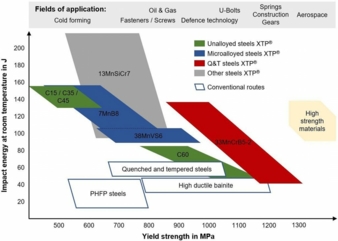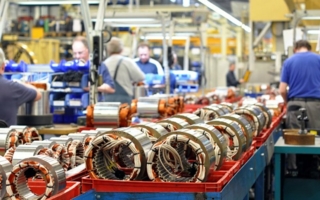03/08/2019
Thermomechanically treated bars with increased performance
With the High Deformation Quenching and Tempering-technology existing ranges of materials can be used for a combination of strength and ductility. The sequence of an intensive forming step with a controllable thermomechanical treatment ensures ultra-fine-grained microstructures.
The trend to constantly increase the performance of different technologies requires the development of new materials as well as enhanced material properties. Therefore, it is necessary to further develop existing alloying and processing concepts. The high demands on the geometric tolerances and the surface condition as well as an evenly distributed fine-grained microstructure and the combination of high strength and high toughness associated with it are crucial quality criteria on the products.
The technology and plant development described below enables new property categories for a broad spectrum of bars of different alloy grades: structural steels, precipitation-hardening ferritic-pearlitic steels (PHFP), martensitic grades, austenitic steels and complex special alloys. In addition, the HDQT plant, highly variable in terms of dimensions and quality spectrum, offers customers from different fields (mechanical bright steel processing, cold bulk forming, hot bulk forming) a wide range of steel bar products with individually tailored microstructures and material properties.
Enhancing the properties of available steels
To reach new categories of mechanical properties within one facility, the High Deformation Quenching and Tempering-technology (HDQT) combines two basic components: an intensive forming step and a thermomechanical treatment. The temperature control is performed in a flexible manner thus enabling a wide range of heat treatment cycles. Thus, after induction heating the rod passes the inlet temperature guidance on its way to the forming unit. In this section, the required forming temperature is set over the rod cross-section by holding, reducing or increasing the temperature. Subsequently, intensive forming is performed for the targeted adjustment of the microstructure using the selected degree of forming, temperature and other process parameters. Depending on the technological concept, forming can be carried out in the ferritic, austenitic or in the super cooled austenitic region.
Immediately after forming, the rod enters the adjacent outlet temperature guidance. At this point a thermal post-treatment or a controlled cooling of the bar takes place with the help of cooling or heating segments which can be arranged in a variable manner. In the subsequent tempering section, the microstructure of the continuous bar can be tempered in an inductive heating system and cooled at air, similar to the conventional tempering technology. So far, the technological concept has been implemented in three industrial plants for final bar diameters in the range 12mm to 45mm. An implementation to larger diameters is also possible.
The specially optimised High Deformation Cross Rolling-stand (HDCR) is the heart of the HDQT-technology. In this intensive forming step, the cross-section of the rod is reduced locally over the bar length within one pass in numerous incremental forming stages. This incremental forming ensures a high surface quality and tolerance accuracy over the diameter as well as ovalities of the bar of under 0.5% (targeting the h9-tolerance after deformation). Simultaneously, high deformation degrees of up to 70% and corresponding degrees of elongation λ of the rod up to 2.5% within a single pass are possible.
The intensive forming step
In order to realise low forming temperatures in the range 500°C to 700°C and the resulting high forming strengths of the materials, the stand possesses over a rigid construction designed for high deformation forces and moment loads. At the end, the concurrent effects of the process-related geometric restrictions, the narrow process windows, the high loads acting on the plant and the targeted high geometric tolerances of the final products make the configuration of the forming unit a challenge.
An industrial HDQT plant was realised in cooperation with the Steeltec AG, and the materials processed there on an industrial scale are available under the trademark XTP. So far, the range of properties of over 20 steels has already been enhanced significantly by the XTP-Technology at this plant. By extensive knowledge of the respective process conditions, a broad spectrum of mechanical properties can be adjusted to one and the same steel grade thus tailoring its material behaviour to a specific delivery condition. The steels processed with the HDQT- and the XTP-technology, respectively, reveal new areas of application for common steel grades. The conventionally rolled 7MnB8 is usually used for cold heading applications. Here, the possibility for further forming of this material after XTP processing was tested. XTP treated bars with an ultimate tensile strength of 1,100MPa – a strength level similar to the one of a 42CrMo4 quenched and tempered steel grade – and an elongation at fracture of 13% were cold bent with a bending radius of 10mm. Even at bending of about 150 degree, no cracks could be detected during microstructural investigation.
Titanium and Nickel-base alloys are our current challenge. Due to the small reduction ratios of these materials, a new HDQT processing scheme including a reverse intensive forming step was developed for this group of materials. Here, the bars can be reheated after each forming step and higher reduction ratios are thus made possible. First tests have already been carried out successfully.
Summary and Outlook
The HDQT-technology allows for achieving new property categories for conventional steel grades. Compared to conventionally treated products, the ultra-fine-grained microstructure together with an outstanding combination of high strength and high toughness as well as tight geometric tolerances are the key advantages of the technology. The HDQT-technology offers a possibility for a product-specific tailoring of both the microstructure and the mechanical properties of conventional steel grades in order to best fit a certain application.
Future work will focus on the use of the HDQT-technology to improve the mechanical properties of both existing and new steel grades in order to enhance the field of their application. In addition, HDQT will be further developed for the successful processing of high-strength materials such as Titanium and Nickel-base alloys.
Gesellschaft fuer metallurgische Technologie- und Softwareentwicklung mbH (GMT)
Boernicker Chaussee 1-2
16321 Bernau/Germany
Tel.: +49 3338 334218-0
Steeltec AG
Emmenweidstrasse 72
6020 Emmenbruecke/Switzerland
Tel.: +41 41 2096363



